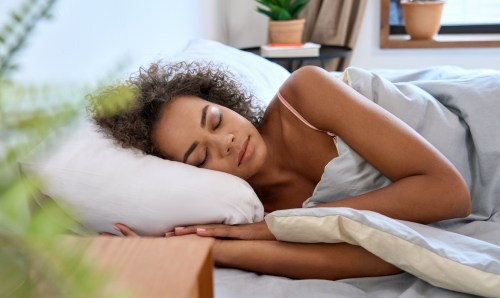How To Practice ‘Lengthened Breathing’ Exercises and Fall Asleep in Minutes
Breathing exercises support quality sleep because they slow down your breath, which increases comfort while reducing stress and anxiety.

It’s probable that you’ve looked for and found at least sometricks to help you fall asleep in record time. But it never hurts to add more tools to your sleep-habits arsenal. After all, when we’re not getting enough sleep, we put ourselves at risk for various health concerns, like disrupted concentration and a weakened immune system. To avoid those sleep deprivation effects, three sleep experts say it’s a good idea to become familiar with and practice lengthened breathing exercises for sleep, which is essentially inhaling through your nose for a few seconds and then exhaling through your mouth for twice as long. Practicing it, they say, can help you drift off to sleep effortlessly by facilitating a state of calm.
Breathing in deeply and calmly through the nose and out through the mouth signals to your parasympathetic system, which helps you calm down, that “it’s time to transition into sleep,” says Raj Dasgupta, MD, FAASM, sleep expert and spokesperson for the American Academy of Sleep Medicine.
Certain breathing exercises support quality sleep because they slow down your breath, which increases comfort and relaxation while reducing stress and anxiety, explains Martin Seeley, CEO and sleep expert at Mattress Next Day, a UK-based bed, mattress, and sleep-accessories retailer. When you’re intentional about calming your stressors or anxiety triggers by using the lengthened breath technique, your mind might just quiet down enough to get good-quality shut-eye.
When you don’t pay attention to your breath, it can become shorter and faster, which increases heart rate—and that’s not exactly ideal for falling asleep.
Your body reacts differently when you’re not fully aware of how you’re breathing. “Our breaths can become short and fast, which increases our heart rate and creates a less than ideal state of mind before bed,” says Rebecca Robbins, PhD, sleep expert at sleep-tech company Oura, creator of the Oura Ring.
How to practice the lengthened breathing exercises for sleep
Start by relaxing into a comfortable position, says Seeley. From there, breathe in for two seconds through your nose, then breathe out for four seconds through your mouth. To get the best results, you’ll want to repeat this for a couple of minutes.
Once you’ve noticed that you’re calmer than you were before you laid down, increase the length of your inhales to three seconds (still through your nose) and exhales for six seconds (still through your mouth), Seeley says. Continue doing this for a few minutes, ensuring that your exhales are twice as long as your inhales, even if you extend the length of your inhales further. So, if you’re inhaling for four seconds, you’d exhale for eight. If it’s a five-second inhale, you’d have a 10-second exhale.
That said, do “be mindful of your own abilities,” says Seeley. “If you extend your exhalation further than your capacity allows, your body will go into survival mode,” which might undo the work that you’re trying to do. To avoid this, start off slow and gauge how long you can inhale and exhale.
The reason for the twice-as-long exhale is that practicing the lengthened-breath technique to help you fall asleep sooner is all about controlling your breathing. The benefits from this technique are at their peak when you’re intentionally breathing this way to calm yourself down.
Moreover, says Dr. Robbins, “adding the complexity of ‘in for two and out for four’ helps us to focus on the breathing and keeps our thoughts at bay.” So the next time you feel like you can’t get any sleep because of anxious thoughts or any other reason, try the lengthened-breath technique to see if it does the trick for you.
Looking for something else to help you fall asleep fast? Watch this video to get an herbal tea recipe for a better night’s rest:










